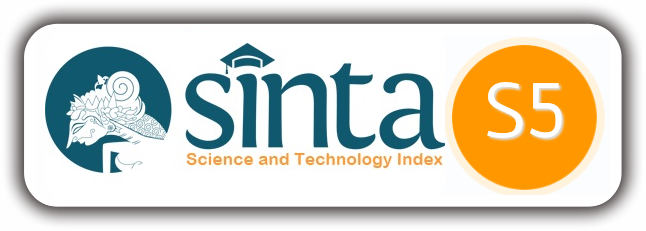PENGUKURAN KINERJA PERGURUAN TINGGI (STUDI PADA FKIP UNIVERSITAS LAMBUNG MANGKURAT)
Maulana Rizky(1*)
(1) Maksi FEB UGM
(*) Corresponding Author
Abstract
Keywords
Full Text:
PDFReferences
Abdul halim, 2007, Akuntansi Keuangan Daerah. Edisi ketiga. Salemba Empat. YogyakartaAlina Lee and Yuningsih Yuningsih. 2011. Multiple Performance Measures of Higher Education : Instrument Development and Validation.Anderson, R. 2007. Thematic Content Analysis, descriptive presentation of qualitative data.Chen S., Yang, C. & Shiau, J. 2006, ‘The application of balanced scorecard in the performance evaluation of higher education’, The TQM Magazine.Creswell and Plano Clark. 2011. Designing and Conducting Mix Methods Research.DiMaggio, P. J., and Powell, W. W, 1983. The Iron Cage Revisited: Institutional Isomorphism and Collective Rationality in Organizational Fields. Dalam W. W. Powell & P. J. DiMaggio(editor). The New Institutionalism in Organizational Analysis (p. 63-82). The University of Chicago Press. Chicago.Djemari Mardapi. 2012. Pengukuran, Penilaian, dan Evaluasi Pendidikan. Nuha Litera. YogyakartaEllen Taylor-Powell., Larry Jones., and Ellen Henert. 2003. Enhacing Program With Logic Model. University of Wisconsin-Extension.Feltham, G.A. & Xie, J. 1994, ‘Performance measure congruity and diversity in multi-task principal/agent relations’, The Accounting Review.Instruksi Presiden Nomor 7 tahun 1999 tentang Akuntabilitas Kinerja Instansi PemerintahI Gusti Agung Rai. 2008. Audit Kinerja pada Sektor Publik. Salemba Empat. JakartaJohn M. Bryson. 2011. Strategic Planning for Public and Non-Profit Organization.Kaplan, Robert S, Norton, David P, 1996. The Balanced Scorecard, Translating Strategy into Action, Harvard Business Press, Boston.Kurz,R.S., Mueller, J.J., Gibbons, J.L & DiCataldo, F. 1989. Faculty Performance, The Journal of Higher Education.Mahmudi, 2005, Manajemen Kinerja Sektor Publik. Edisi Kedua. Sekolah Tinggi Ilmu Manajemen YKPN. Yogyakarta.Mahsun, M, 2006. Pengukuran Kinerja Sektor Publik, BPFE Yogyakarta, Yogyakarta.Mardiasmo, 2002. Akuntansi Sektor Publik. Andi. Yogyakarta.Mark Friedman. 2009. Trying Hard is Not Good Enough.Mudrajad Kuncoro, 2011. Perencanaan Daerah, Salemba Empat, Iromejan.Paul F. Mc Cawley, The Logic Model for Program Planning and Evaluation. University of Idaho Extension.Peraturan Menteri Negara Pendayagunaan Aparatur Negara Nomor PER/09/M.PAN/5/2007 tentang Pedoman Umum Penetapan Indikator Kinerja Utama di lingkungan Instansi PemerintahRepublik Indonesia. 2013. Peraturan Pemerintah Nomor 58 Tahun 2013 tentang Bentuk dan Mekanisme Pendanaan PTN Badan HukumScott, Richard W. 1987. The Adolescence of Institutional Theory. Administrative Science Quarterly 32 (4):493-511Szeto, W.F. & Wright, P.C. 2003, ‘Searching for an ideal; a cross-disciplinary study of university faculty performance evaluation’, Equal Opportunities International, vol.22, Is.8, pp. 54-66.Shao, L.P., Anderson L.P. & Newsome, M. 2007, ‘Evaluating teaching effectiveness: where we are and where we should be’, Assessment and Evaluation in Higher Education.Sofyan Yamin dan Heri Kurniawan. 2011. Generasi Baru mengolah Data dengan Partial Least Square Path Modeling. Salemba Empat.Bandung-JakartaThe Performance Based Management Handbook. 2001. A Six-Volume Compilation of Techniques and Tools for Implementing the Government Performance and Result Act of 1993 (GPRA)W.K. Kellog Foundation. 2004. Using Logic Models to Bring Together Planning, Evaluation and Action. Michigan.Zainal Mustafa EQ dan Tony Wijaya. 2012. Panduan Teknik Statistik SEM & PLS dengan SPSS Amos. Cahaya Atma Pustaka. Yogyakarta.
Article Metrics
Refbacks
- There are currently no refbacks.
This work is licensed under a Creative Commons Attribution 4.0 International License.
______________________________________________________________________________________________________
2302 - 1500


_logo2.png)





